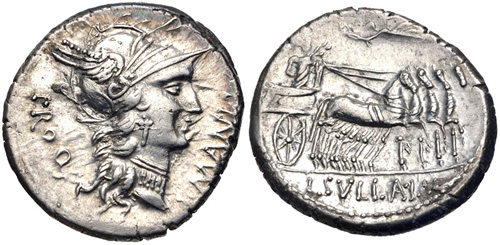Sulla Silver Denarius
Lucius Cornelius Sulla, often referred to simply as “Sulla,” has the honor of being the first living person depicted on Roman coin. Sulla also played a significant role in the fall of the Roman Republic and the rise of its empire under Julius Caesar.

The next time a living person appeared on a Roman coin occurred about three months before Julius Caesar was murdered by his colleagues. Many point to the coin as additional evidence to support people’s fear that Caesar wanted to be a king and because of that ambition he was a threat to the Republic.
Rise of Sulla and the Roman Republic
Like many ancient rulers, Sulla’s rise to power is framed by war. A skilled general, he aligned himself politically with the Optimates, which sought to maintain the supremacy of the Roman Senate. He was opposed by Gaius Marius, who led the Populates, a faction aligned with the people rather than the Senate.
The conflict between the two groups came to a head when Sulla marched on Rome with his army and defeated Marius in battle. Sulla then marched on to Asia Minor, where he defeated King Mithridates of Pontus. When he returned to Rome, Marius had regained control of the city. In the second battle, Sulla was again victorious.
In 82 BC, the Senate bestowed the title dictator legibus faciendis et reipublicae constituendae causa on Sulla, which means “dictator for the making of laws and for the settling of the constitution.” Sulla used his broad power to restore the power of the Senate and enact economic reforms. However, he also carried out brutal proscriptions, killing thousands of Romans perceived to be a threat to the Republic.
In 81 BC, Sulla resigned as dictator and returned authority to the Senate. Two years later, he retired from public office. Sulla died not long after. While Sulla relinquished his power, he had destabilized the Roman power structure and set the stage for future dictators, including Julius Caesar.
Denarius of Sulla
The denarius was the standard Roman silver coin for almost five centuries, including during the reign of Sulla. Many of Sulla’s denarius coins were minted in Rome, while others were produced by a military mint that travelled with Sulla.
The obverse of the denarius issued by Sulla features the helmeted head of Roma, the divine personification of the city of Rome, on the right. It also includes the inscription L. MANLI. PROQ , which refers to his proquaestor during the Pontic war, L. Manlius Torquatus.
The reverse side of this coin shows Sulla in quadriga, riding towards the right. Quadriga is a Latin word meaning a chariot drawn by four animals. On the coin, all four horses are in a perfect row leaning forward. Sulla is crowned by a Victory, who flies above in the upper part of the field. He is holding reins and a caduceus, a winged staff with two snakes wrapped around it.
